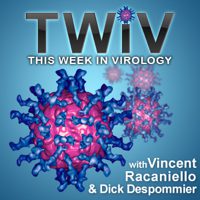

There are many ways to listen to TWiV:
- Subscribe to TWiV in iTunes by clicking here.
- TWiV is also on the Zune Marketplace.
- Listen to TWiV on your mobile device with Stitcher Radio or the Microbeworld iPhone, iPod Touch, and iPad app.
- Subscribe to TWiV by email or by RSS feed.
- Individual podcasts may be played or downloaded at the TWiV website, which contains a complete archive of all past episodes.
Whichever way you choose, you’ll get the latest information from the only podcast dedicated to helping you understand all about viruses – the kind that make you sick.

Hi there, I am layman (or rather a laywoman) from Sweden, eager follower both to your podcast-sessions and your lectures on virology blog. Thanks for this fantastisc initiative!
I have a question to you: Dr Henry L Niman, a flu tracker and Ph D from Pennsylvania
http://www.recombinomics.com/whats_new.html
is very critical to WHO's standpoint in saying that the severe RBD D225G and D225N in H1N1 are spontanous and random. He argues that labtests published on GISAID prove that there is transmission due to several cases close in both time and space.
http://fluboard.rhizalabs.com/forum/viewtopic.p…
Have you any comments on that?
Hi there, I am layman (or rather a laywoman) from Sweden, eager follower both to your podcast-sessions and your lectures on virology blog. Thanks for this fantastisc initiative!
I have a question to you: Dr Henry L Niman, a flu tracker and Ph D from Pennsylvania
http://www.recombinomics.com/whats_new.html
is very critical to WHO's standpoint in saying that the severe RBD D225G and D225N in H1N1 are spontanous and random. He argues that labtests published on GISAID prove that there is transmission due to several cases close in both time and space.
http://fluboard.rhizalabs.com/forum/viewtopic.p…
Have you any comments on that?
i have a doubt of a kind…suppose an outbreak has occurred and is of mild or huge mortality. and the causative agent is found to be a virus…but the one not present in all known virus database… then how to characterize this unknown virus (like have DNA or RNA genome, whether segmented or continious, surface proteins it possess for attachment to host cell, no of protein subunits it encodes, etc) and how to step for its diagnosis typically during an outbreak situation…?
Do you know that a sponge is dirtier than money and that money is dirtier than a toilet.
H1N1 back in Canada. Is my vaccination from 2009 going to protect me this round??
What is your advise.
please check out Dr. Rider work with DRACO at http://www.thedracofund.org If the right minds got together and made this work it would effect the lives of billions.
Is there anywhere on the website where the picks of the week are listed? It would make it a lot easier to find some of the links. Thanks!
Who wrote this?